Miranda in Shakespeare's Tempest at one point proclaims "O brave new world that has such people in't," giving rise to numerous quotations of the "brave new world" phrase, usually implying something futuristic and revolutionary. This is mostly due to the eponymous novel by Aldous Huxley centuries later, in which the fast pace of the future poses risks of losing one's identity - indeed, "everyone belongs to everyone else."
The Miranda-style use of the phrase implies an embracing of the new - she is naïve and innocent, merely delighting in something she could not have imagined. In some ways, you could say such a person is the anti-Luddite, so open to any new technologies that they seem drawn to it only because it glitters in the sun.
The Huxley-style use of the phrase is much darker; Huxley's novel takes what is supposed to be an optimistic utopia and parodies it; individual freedoms are endangered, and in fact no longer even part of the conversation.
There's a brave new world coming to Disney World soon, but whether it's Miranda's or Huxley's remains to be seen (the answer may, in fact, depend on your outlook on life in general). Al first broke the news here back in April 2009, but in the past two months more media outlets have also been reporting on Disney's "Next Generation" (NextGen) project.
We still don't know much about NextGen. It's secretive, and company officials won't go on the record about details. If the secrecy reminds you about other giant theme park projects (Project X, which became Walt Disney World, leaps to mind), then you'll be doubly interested once you discover that the price tag for this project is reportedly over a billion dollars (some insiders claim $1.5 billion).
Let's put that into perspective. The original Disneyland was built in 1955 for $17 million (in 2008 dollars, that's $135M), while DAK cost almost $1 billion in 1998 (about $1.3 billion in 2008 dollars). So Disney may well be spending as much money as a complete theme park, though amortized over time, on this new initiative. Pause to consider the ramifications. Fan sites go gaga over even minute changes to the show experience (I may know someone like that, ahem!), so why isn't the blogosphere exploding with more questions and speculation? I think it might be because we just don't know enough yet.
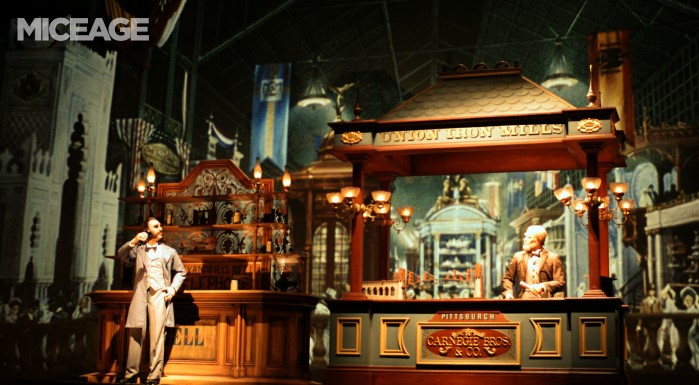
$1 billion could have bought a lot of animatronic extravaganzas!
Here's what we do know: NextGen is headed up by Jim McPhee (Epcot's former vice-president), according to an announcement in December. While McPhee's duties may include show quality suggestions at all Disney parks in America, his particular focus will be on a mysterious DDK. The initials are not explained anywhere – maybe Disney's Digital Kingdom? Whatever it is, DDK has NextGen's central technology at the core: Radio Frequency Identification (RFID). You've probably heard of RFID in its increasingly common merchandise application. Wal-Mart, for instance, uses RFID to know when items are purchased, and must be re-ordered (or re-stocked on the shelves). It eliminates waste.
How might Disney RFID function? It could probably similarly do a bang-up job of eliminating waste. But in Disney's case, the thing being tagged with a tiny chip isn't the merchandise in the stores, it's the people visiting (in other words, YOU).
Great Wolf Resorts has been experimenting with RFID wristbands, so visitors can use these things just like today's visitors use the Key to the World card (combination hotel keycard and charge card)… only in a waterproof, always-with-you format. The company Great Wolf turned to was Precision Dynamics, which tellingly just signed a deal with Disney and is not allowed to talk about it. If Disney goes the wristband route, you can imagine that some of the cost of implementation would be replacing all the door locks on property, about 25,000 hotel rooms.
Some of the speculation centers around ticket media instead. If RFID were added to existing tickets (such as Key to the World cards or new-style annual passes), then replacing door locks might not be necessary. But there are still countless benefits to imagine from RFID becoming ubiquitous.
Let's start, again, with becoming more efficient and eliminating waste. Since visitors are not the tagged items, the system will know might know when visitors are bunched up--say, after Fantasmic at Hollywood Studios. Extra busses could be routed there from elsewhere, assuming such a flexible schedule could be constructed. Perhaps something like the military's "alert fighters" that launch at a moment's notice?
Similarly, when there are few visitors around, Disney would have some solid data to make decisions about future operations. This sounds ominous, and in fact could turn out to be customer-unfriendly. What if they decide to open parts of the park later, because they just don't attract enough visitors in the first part of the day? Let's not forget that this already happens: witness Epcot's World Showcase, which doesn't open until 11am. Something similar happens on a smaller scale to individual rides at most of the parks; they have their own operating schedule separate from the park's stated hours. This exact phenomenon used to enrage Walt Disney when he walked around Disneyland, but it's what they've done for years now post-Walt, and the public has largely shrugged it off. It's conceivable that RFID could provide enough data to make even more finely-tuned suggestions in the future.
But that's veering into the cons already, and there are still numerous pros to consider. Ever see E.T. speak out loud the names of all the riders at the end of the Universal attraction? That sort of thing is laughably easy in the RFID era, especially because the RFID system will already know your name.
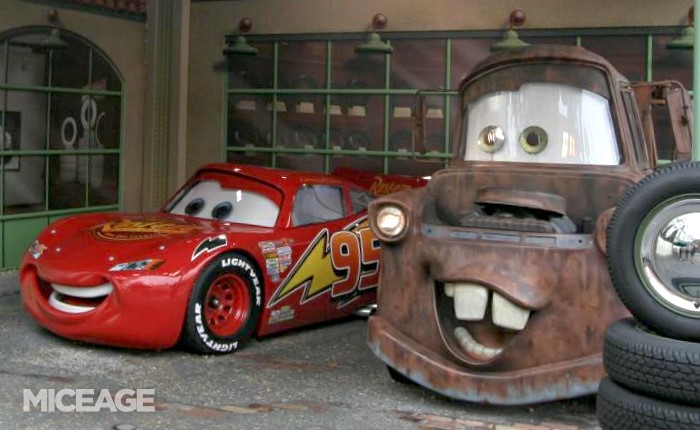
Veruca Salt would probably want a Mater "Now, Daddy, NOW!"
… especially if Mater just spoke to her by name.
One idea being examined is to have visitors fill out a survey before they arrive. We don't know what kinds of questions they will be, but I'm betting they will be things like: what rides are important to you? Who is your character? Do you like churros or turkey legs better? What dietary restrictions do you have? Check off all the types of souvenirs you've bought before.
Because they'll know your name, they can really customize things. One online poster had heard about "good night" wishes delivered right in your Disney hotel room… by Cinderella appearing in the mirror and expressing her fondest wish that you, [insert girl's name], have a GREAT night! If true, this could also be expensive. Think about how many models they will have to hire for the recordings, and how many takes each model would have to do! (there are hundreds, even thousands, of names!) But it would also definitely add a spark of magic to that little child's vacation, no doubt about it.
Because your survey asked you which rides you considered important, maybe the system would notify you if something relevant comes up. As you leave Tomorrowland, your cell phone rings (or maybe it sends an SMS text message?) and you hear that Pirates of the Caribbean now only sports a 15 minute line… something you like to hear, since you listed it as a "must ride" on the survey. Or conversely, you get notified just as soon as the park knows it that Pirates has just gone 101 (Disney-speak for shut down temporarily for mechanical or operational difficulties). That could be handy indeed.
We've seen hints of this coming for a long time. On the one hand, you've got the now-discontinued Pal Mickey, a stuffed toy that reacted to GPS sensors around the parks to deliver pre-recorded trivia, park updates, suggestions, and even bad pun jokes. More recently, the Kim Possible cell phone game enabled interactivity with the environment on puzzle-type quests (it's really fun!) - just click through the quick cartoons, report to a new spot in the France pavilion, click a button, and watch something in the environment slide open or move around because you "scanned" it. Even the Living Character Initiative (things like animated versions of Crush or Stitch interacting in real time with the audience) probably can be included in this long developmental path.
Disney has long been interested in using technology to alleviate the number one complaint about its parks - long lines (FastPass, you see, does not really reduce the complaints about lines; it just shifts so that the complaints are coming from a different demographic). We saw clues of this future when Soarin at Epcot added an interactive queue to the Standby side; visitors jump, dance, and all sorts of other things to influence the jumbo screens above them, while sensors track their movements. The more recent Space Mountain refurbishment has provided video games to play, in the truest sense of the word (there's a version of Asteroids even!)
But the real revolutions have happened elsewhere. They showed up first at Pooh's Playful Spot (of all places!), an often-maligned playground in the MK where the Pooh characters can be seen, usually with long lines. Instead of standing in line for photos, interested parties in December were handed an electronic device and told to feel free to explore the playground - when it was their turn, the device would let them know to return right away, and they could meet Tigger with the barest hint of a wait. The concept is an awful lot like the buzzers common at Olive Garden (or countless other restaurants), only since this is a Disney park, they can build things to actually *do* while the time ticks by.
The Pooh test ended quickly, but the "queueless wait system" concept popped up again a week later at Rock n' Roller Coaster. For that day only, they turned off the FastPass machines and designed the entire area (from the gates-with-upside-down-car forward) as the play zone. If you wanted a buzzer (it doesn't actually buzz), you told them your party size and settled in for a wait. On this test, they had video games set up like Guitar Hero. You knew it was your turn because your ticket had a special group number printed on it (such as "C2") and when they were calling your group, you had a 15 minute window to return, or else forfeit your spot.
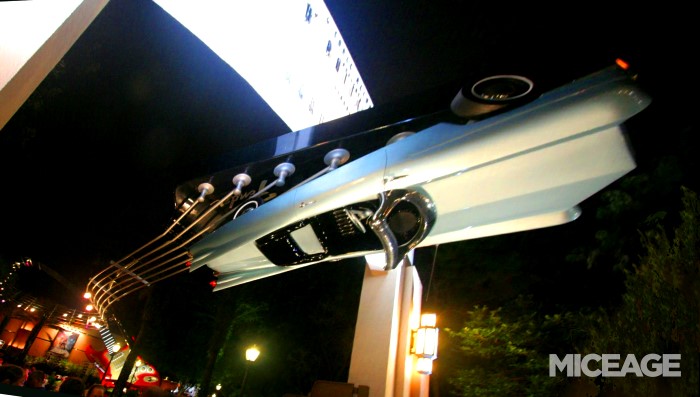
Rock ‘n Roller Coaster: ground zero of the one-day test
These two tests are obvious lead-ins to the system expected to be used at Dumbo (or "Dueling Dumbos," as several folks are calling it) when it reopens in a new location after the Fantasyland refurbishment. Ever since the blueprint was leaked, people have been curious about the phrase NEXT GEN QUEUE adjacent to Dumbo, and now we know what it will look like. It will be a walk-anywhere, play games or do other diversions, while you kind of stand in line virtually.
FastPass was originally billed as a virtual queue, but that phrase doesn't really capture the entirety of its significance. I think of it instead as a doppelgänger creator. With FastPass, you drop an invisible clone of yourself in the line at Space Mountain, and then the real you goes off and rides Haunted Mansion.
The queueless wait system (I hope they have something more sexy than QWS to call it) is a real virtual queue. In one sense, you are still dropping off a virtual clone of yourself to stand in line so you don't have to, but with the "group boarding time" concept, people will be far less likely to wander off and ride other rides. In other words, if you want to ride the ride, you will put in the time to wait for it. Either you wait for it in a "regular" line, or you have your clone wait while you play games or just sit on the bench. And personally, I'm hoping they just make this the ONLY queue. No more separating standby or FastPass. That will really level the playing field.
Reports from the Rock ‘n Roller test said customers were free to leave the area, but there were signs up saying that if you didn't happen to be here when your group was called (remember: a fifteen minute window), then you had lost your place in line. That will probably serve to kill off any desire to dart quickly over to Haunted Mansion while waiting for Dueling Dumbos. Instead, people will loiter, and play whatever Disney sets up. I'm imagining exhibits and interactive things – maybe like the Living Seas exhibit halls, but even more interactivity.
There's an awful lot to like about queueless waiting. It keeps all the advantages of FastPass (such as not having to stand in a boring line, shuffling forward like cows mindlessly following their herd into the killing chute), while neutering some of the things I perceive as shortcomings of FastPass. These boil down to knowledge gap issues: some tourists don't know to use FP and as a result get fewer rides per day. Or they may not realize that they are being short-changed, on a systemwide level, if they do not send out runners to collect FP as soon as a window opens, while the rest of the clan relaxes. Or that they can hold FPs for some rides that are "disconnected" from the network. Or that you can return late, despite what it says on the ticket, and still ride.
And lastly, those infrequent visitors don't know which rides really NEED FastPass (such as Splash Mtn) and which can be bypassed (Pooh), thus saving the FP for a rides that has horrible stand-by lines. All of those are knowledge-gap issues. They are great "exploits" for someone like me who visits every week, but it's fundamentally not fair, and it leads to complaints still in City Hall, as well as grumbling by visitors in the Standby lines. I like the queueless waiting will probably resolve all of those inequalities neatly and elegantly.
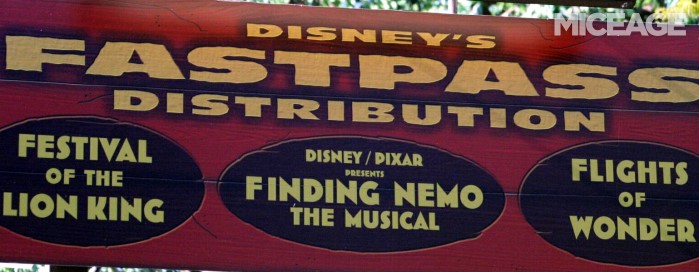
Are the days of FastPass numbered? I could only dream!
Remember Disney's original reason to install FastPass? They wanted to generate additional sales in stores and restaurants, of course: "Let's take all the people out of lines, and let them roam about so they have time to shop and eat." It hasn't really worked out that way, at least not to their satisfaction. But it's my hope, even my belief, that queueless waiting will find middle ground that makes everyone happy. People will be reluctant to stray too far from the ride (lest they miss their window, which ought to be much quicker than we now see in FastPass, since there is only ONE line rather than two). And since they want to stick around, they may be more willing to amble into a store, or feel that while a 20-minute line at the Haunted Mansion (plus walking time) is risky, they have enough time for a turkey leg or a churro. In other words, Disney gets what it wants (more dining and shopping), and customers get what they want (not standing in line).
Let's not act surprised if more shopping carts spring up, and additional food carts as well. In fact, it wouldn't shock me if this initiative, should it go large-scale, created ripple effects in other park operations, like foods. If people are more likely to be stuck around a ride and snacking all day, they may be less hungry for all you can eat buffets. Will we see more fast-food options as a result? Will people be less likely to make dining reservations, which "tie you down" a bit and give you less flexibility? Under today's system, having a reservation doesn't mean less flexibility – just get your FastPass anyway and return "late" and still ride. Not so under queueless waiting.
One online report claimed that the upcoming Small World refurbishment coming this year may see some RFID technology folded in. That may seem a bit early, but if Disney wants this up and running in a big way in Ariel and other Fantasyland rides by 2012, I could imagine them taking the baby steps now. And speaking of timeline, it may be cynical, but I am placing my money now on Disney announcing the full extent of the RFID initiative right when Harry Potter mania (at Universal) is at its peak, perhaps when Wizarding World opens next year and Disney is still 12 months away from their corresponding volley, the Fantasyland expansion.
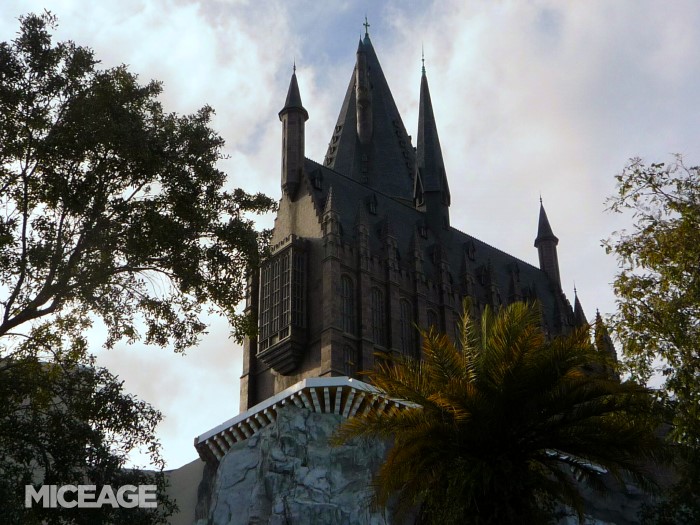
Universal has almost finished work on the exterior of Hogwarts.
That's an impressive set of positive developments. But there are negatives to consider as well. Earlier I pointed out that $1 billion would have been easily enough to build a full-sized fifth theme park. Momentary fanboy wet dream: what if part of the $1 billion is for a fifth park, but scaled down (boutique-sized) and built from the start to be RFID-ready (rather than slap RFID interactions on rides that were not designed for it)? There's been zero chatter on this one, so I don't really believe it, but a fanboy can dream, right?
Assuming we get no such park, it's not out of place to question the huge cost. Remember when DCA was announced and then built in the late 1990s? Disneyland got no rides of mention for a LONG time. As Al predicted in his online columns back then, DCA became a heroin monkey on Disneyland's back, sucking up all the big development money. Something similar may well happen in WDW. What are the big rides in development right now? What will 2010 bring us? Well, mostly refurbishments. Some of those are not just maintenance, but actual enhancements (think Sparrow on Pirates, or the startingly-good additions to the Orlando Haunted Mansion). Enhanced rides are a ton cheaper than brand new ones. Can years of stagnation (ride wise) be good for WDW, even if new interactions spice up the existing rides?
A cynic might question whether my scenario of enhanced shopping and dining was too rose-colored. FastPass should have done the same thing, but didn't, so might this not reveal something about human nature rather than FP's implementation and unintended consequences? I'm all for hard questions, especially before anything is built, but my money is still on queueless waiting actually striking a balance that will make everyone happy. Well, everyone except maybe those who got used to FastPass and the imbalances they created in favor of the super-informed visitor – such people would indeed lose something if FP were to be eliminated (something I have heard no one whisper about, but it's logical to question if that's the endgame).
It could be argued that filling out a survey months in advance might not be a realistic way to capture what people really want. Already there are folks who don't plan ahead – they want vacation to be a time of NON-thinking, after all – and these are the folks who in today's parks walk up to the restaurant podium and are annoyed (even angry) that there are no spots for them. What will that kind of visitor think about deciding on favorite rides so many months in advance? Certainly it could call for online and book research – which rides will I really want to make sure I see? And, of course, Disney would have to find a way to make the survey compelling, not something people blow off after they book the hotel.
Here's a big one to consider: if people are not in the lines, they will be somewhere else (duh). Part of the reason 60,000 people in the Magic Kingdom doesn't feel like 60,000 is that thousands are stuck in line at any given second. If they aren't in line, won't they be in the walkways, clogging things up impossibly? I grant that possibility. However, we may catch a break here if they phase in queueless waiting at the same time that they phase out FastPass. Remember my doppelgänger metaphor earlier? In today's park, my virtual clone stands in line at Space Mtn while I clog up the walkways. In tomorrow's park, I'm likely to stay close to Space Mtn while my ticket "matures" – so we could in fact see a REDUCTION, not an increase, in walkway crowds if the numbers add up (something only Disney knows, of course).
I do see a risk of homogenization, however. Remember that RFID is being implemented everywhere to cut out waste. What looks like waste to an "accountanteer" may be one of the things YOU like best about the parks, your little magical secret. Perhaps it's an out of the way place for relaxation that Disney could turn into a profit-making shop (and henceforward busy and thus solidly nonmagical).
We mentioned earlier that RFID could generate a lot of data to help the parks streamline operations. Efficiency is a good word when it means your wait for a cheeseburger is reduced, but it's a bad thing when it means that experiences will be closed at the start of the day (World Showcase) and others at the end of the day (Future World) in the name of efficiency.
Disney has always striven for a cure to the bane of many industries, the boom and bust of the business cycle. In Disney's case, that means the off-season. They've moved mountains already to eliminate almost all of the traces of an off-season. Courtesy of clever marketing and compelling discounts, they can lure people to Disney in the non-holiday months. And they've really got the scheduling (and early-releasing) of employees down to a marvelous science. Again, efficiency is a double-edged sword. All that efficiency means there are few days that can be seen as truly off-season, with no crowds and no lines. In such a day, Disney already knows to schedule fewer workers, meaning fewer vehicles on the tracks at the rides, and thus lines after all. And RFID will help them further refine the science.
After all, Disney is spending $1 billion on this. They are not a charity; this is a business, and they expect Return on Investment (ROI) for their money. I shudder to think about how much money this mega-corporation is expecting to wring out of visitors if the *investment* is a billion dollars.
The net result of so much efficiency could well be homogenization. With everyone designed to get exactly 10.2 rides per day in the park, and 2.3 character interactions, something just smells off about the formula. After all, when you think about it, economics and magic are diametrically opposed. You can't really have one and still have the other (at least most of the time). If you reduce the "magic" down to a science enough, it will start to feel too packaged, too artificial. Like something out of a Simpson's episode, perhaps, where everyone waits forty minutes in line for their pre-packaged bit of, ahem, "magic." Trouble is, that happens NOW (witness lines for characters, for instance), and it still works on the little kids. Still, adding even MORE homogenization and efficiency won't be good.
Some of what we fans now see as Declining by Degrees are actually products of "Accountanteering" – calculating by spreadsheet what the crowd dictates, and aiming products and experiences at the BULK, not the little parts of the audience. This is why Epcot never stays open late except on very rare holidays, and why many rides open later than the park in the morning. RFID data mining is sure to bring more such "movements toward the center" of the crowd, increasing overall homogenization.
That can't stand. It's already bad enough that parks close so darn early, even in summer. It's worse that some rides are closed in the first part of the day simply because they aren't popular. Too bad. No amount of regression analyses and two-tailed T-Tests will ever capture the importance of "quiet spots" in the park, or the unquantified feeling of magic that all the rides are open as you stroll around the non-crowded park.
Disney is in the business of selling magic, not widgets. For goodness sake, they had better remember their business model before people tune out (and some already have). No matter how much they protest to the contrary, Accountanteers can never quantify the "magic" to a complete science, and they get it wrong sometimes (such as the fan outrage at plans to remove the non-popular Lincoln in Anaheim, or the end of Lights of Winter at Epcot).
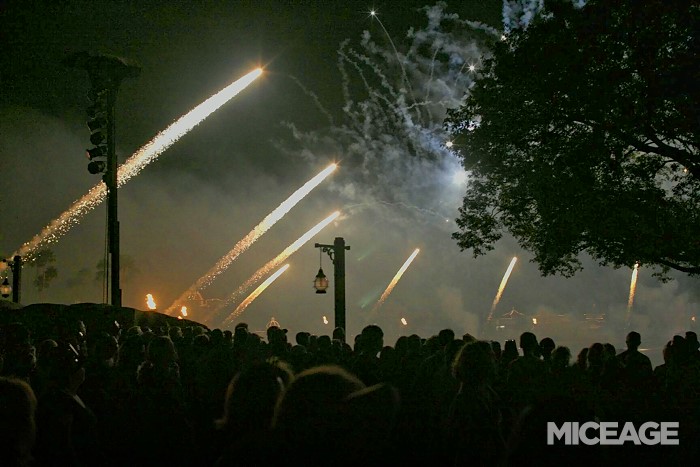
"I know how to save money – we'll funnel everyone to the same
show at the end of the night!"
Then there are privacy concerns. For some, this will be potentially the biggest issue. Disney will be able to track where you eat, what you rode, where you relaxed. That will be useful data, but I'm guessing their reach is further than passive data collection. Remember that expectation of ROI! If they expect to make "additional" money from this investment, they'll find ways to monetize it. If you tell them on the survey you like Figment, will they maybe text message you that Figment collectibles in the shop around the corner are $59.99 each? Even if you never reply on a survey, their data mining will probably detect patterns over time, since they are sure to track individual users (the whole point of this is customization and personalization, remember?)
There's some debate among online pundits whether RFID will be voluntary or not. You could skip a survey, certainly, but what if your ticket media *is* the RFID device? That will be true for probably everyone but the day visitors.
It's true that RFID has limited range. The new passports can be read at about 18 inches, though if you wrap them in aluminum foil, you have to be within two inches for the chip to be read (the foil is not foolproof). But who's to say that Disney's version will have the exact same range? Even 18 inches is close enough to track my rides throughout the day. I could imagine them outfitting all ride entrances with RFID sensors. Surely I come within 18 inches of the turnstiles at any given ride.
I'm aware that we're in Twilight Zone territory here, talking about aluminum foil to prevent unwanted intrusion from the outside. I used to mock such crazy behavior as much as the next person, but darned if I'm not earnestly considering a wad of aluminum for my own annual pass in 2012, whatever it ends up looking like.
Disney already knows my name, address, and cell phone number. Would it be helpful or creepy if they started calling me to inform me that "We noticed you have no dinner reservations for tonight, and Mama Melrose presently has tables available"? Maybe a bit of both?
Will they WANT to let people opt out? I'm not sure Disney spends $1 billion only to make the technology optional. They want ROI, so I wonder if they wouldn't make it compulsory.
Even if they find a way to let people opt out, I worry about the Disney park version of "net neutrality." In the backbone of the Internet, there are presently policy debates about the owners of the "pipes" being able to set speed limits on some traffic. Cable companies, for instance, built many of the pipes and want to give priority to THEIR traffic (which would benefit subscribers to their Internet service). The concept of net neutrality would treat each packet of data the same, regardless of origin and destination. Would Disney be able to maintain a similar theme park neutrality, regardless of RFID orientation? Or would the "chipped" people get special treatment, shorter wait times? It occurs to me that this sounds like ethical dilemmas we're all sure to face once human augmentation becomes possible via microchip implant. Do I "chip" myself and harvest these rewards, or do I stay natural and lose out (even if it's just a bit)?
Privacy issues are nothing new, and for that matter Disney is far from the first company to use RFID. Supermarkets know what you order based on your reward card, credit card companies know which shops you frequent. No one is saying that Disney's move is revolutionary or endangering freedoms immediately. But it's worth pondering just what it says about us if we simply acquiesce without so much as a question. More RFID? Sure, sign me up!
The shelf at Wal-Mart doesn't say "Thank you, Kevin!" when I remove a bag of Cheetos, but Disney's parks are soon to do something like that. That make strike some as creepy, or at least a bit unnerving. We really are moving, as a society, toward that scene in the Minority Report movie when Tom Cruise's character gets bombarded by personalized advertisements in the mall. To those who think Disney wouldn't resort to such invasive advertisements, I ask again just what Disney hopes to reap for its billion smackaroos. Why would they invest if they don't expect to make ADDITIONAL money (not just continue the same money) from the investment?
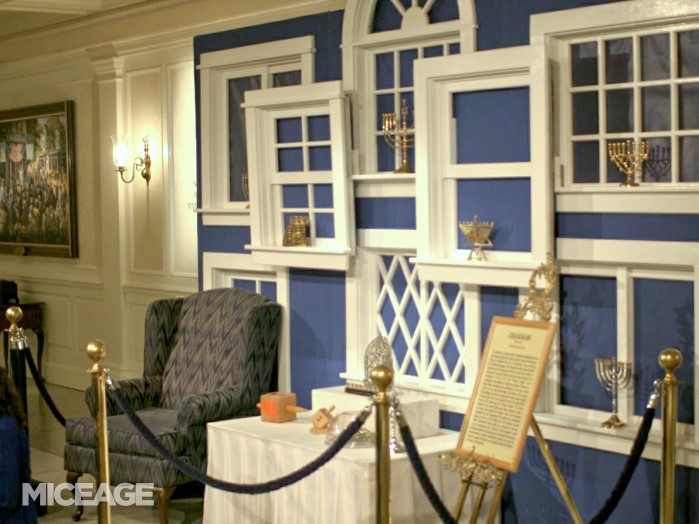
This new exhibit in the American Adventure doesn't talk to visitors.
But would a future version?
Let's hope they can find the *right* balance. Disney is looking to fundamentally re-invent the theme park experience, right down to the level of expectations (and this, when you come down to it, is the real story!) Perhaps the balance they are looking for is fun, "magical" encounters that radically change the tenor and feeling of a theme park visit, rather than reach into your pocket even more. The Destination Disney initiative did wonders to get people staying on Disney property alone, and not venturing off to competitors, and the NextGen project will hopefully deliver equally magnificent results.
Will they manage to pull off the right balance? I've told this story online before: when I visited the Epcot-25 anniversary room in Future World, I observed a manager off to the side, silently observing the crowd. He was wearing a Jim nametag, so I gambled and went up to ask him if he was Jim McPhee (who was then in charge of Epcot). He was, of course, and I was delighted to shake his hand.
I've worked with dozens of Disney execs over the years, and observed hundreds more in the decades since, but almost NEVER have I seen someone act like Walt Disney used to act, just listening humbly in the corner to what people were saying. Jim didn't have an entourage with him – he was alone. His one interest was in knowing what the public wanted. I don't know about you, but I'll take a listener like that any day of the week over just about any other kind of leader. If he's in charge of NextGen, I'm quite willing to give him the chance to prove that he can strike the right balance.
And Jim, more than just about any other manager, is sure to keep his eye on the real ball, which is not frequent visitors like me, but the infrequent tourist who is the bread and butter of the Orlando parks. For such visitors, NextGen has enormous potential. Want to prioritize these exact eight attractions and just these three Disney characters? Odds are good that NextGen will make that possible.
It will be hard to argue with success like that, even if it means we gave up the budgetary equivalent of a fifth park to get it. As always, the bottom line goal should be on out-of-town visitors. If they have a good time and want to come back, then WDW has every incentive to keep things pristine and ever-refreshed, which is good for all of us.
O brave new world, that has such theme parks in't! |
